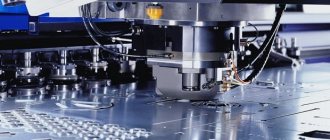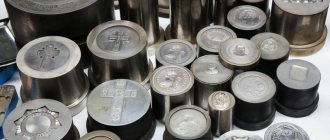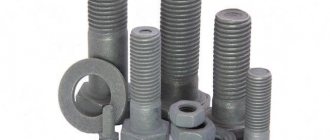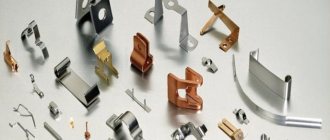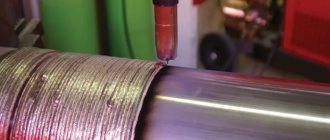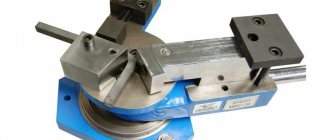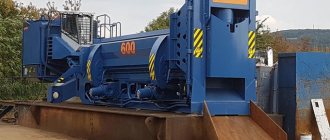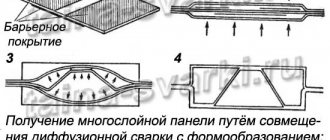Home → Products → Stamps
Prices for the production of stamps for stamping from 44,000 rubles.
To calculate the cost of products, call or fill out the form By clicking the “Submit” button, I confirm my consent to the processing of personal data
Punching Bending Drawing Forming Combined action Sequential action
The production facility provides a full range of services related to the production of dies for metal stamping in Moscow and throughout Russia. We produce tooling for stamping of any level of complexity according to customer drawings in compliance with GOST requirements.
Features of stamping technology
Stamping is a complex technological process during which a metal workpiece is subjected to mechanical pressure, which leads to its plastic deformation. To perform such processing, special equipment is used. As a result of its influence on the material, workpieces of the required shape and size are obtained. The main raw material used for stamping is sheet metal of different thicknesses.
This processing method is divided into two types:
Cold stamped parts
- hot. Involves preheating of workpieces;
- cold. The workpieces are not heated before stamping.
Hot stamping is used for materials that do not have high ductility. This processing method is most often used in the production of workpieces in small batches from metal sheets having a thickness of 5 mm. When manufacturing parts, it becomes necessary to apply large tolerances. When they cool, warping and other negative processes occur that affect the size of the future workpiece.
When performing cold stamping, special equipment is used. During processing, the material is further strengthened, but its plasticity is lost. To prevent increased fragility of finished products, they are additionally subjected to recrystallization annealing.
Why do you need a stamp?
The basis for the production of any name is the absolute identity of two or more units. This requires a single form from which all other products will be created. It is necessary, including for hot stamping. This is exactly the kind of preparation I am ready to offer. Using this product, you can maintain specified parameters when producing even complex shapes.
Hot die forging is one of the most popular metal processing technologies, using heated sheet metal to form a forging, which is processed under high pressure. It is suitable for the manufacture of various parts: for cars, aircraft, agricultural machinery, etc. However, without a good stamp it is impossible to achieve uniformity in the resulting product. NGS is ready to produce it in strict accordance with the client’s requirements.
Customized production of hot stamping molds provides the following advantages:
- compliance of the element with customer or equipment requirements;
- reproduction of even the most complex and non-standard sketches;
- production accuracy with minimal error.
Features of cold stamping technology
Cold stamping technology involves processing workpieces by changing their shape and size, but maintaining other geometric characteristics.
Strips, tape or sheets obtained from alloyed low-carbon steels are used as raw materials to obtain the necessary products. Alloys of aluminum, copper, brass, magnesium, titanium or other highly plastic compounds can be used. This is due to the fact that such materials are easily deformed.
List of operations performed during stamping
During the process of cold metal stamping, various operations are performed that help give the product the required characteristics. They can be separative and shape-changing. In the first case, the surface of the material is partially separated along the specified contour. Separation operations include:
- cutting Separating part of the workpiece along a straight or figured line using a press in the form of scissors;
- punching Performed to create a hole of the required shape and size in a part;
- cutting down The finished part looks like a closed contour.
Classification of basic stamping operations
Form-changing operations during stamping involve changing the shape or size of a sheet metal workpiece by moving its parts in a certain way. In this case, physical destruction of the part does not occur. The most common form-changing operations include:
- hood. Refers to volumetric stamping, with the help of which hollow parts of various shapes are produced (cone, cylinder, hemisphere, cube);
- flexible. With the help of such stamping, the bend of the sheet material is given almost any shape;
- relief molding. Implies local changes while maintaining the configuration of the workpiece itself;
- cold landing. Allows you to obtain a part of the required length with an increase in its diameter.
It is possible to stamp using a combined method, which involves dividing and shaping the part.
Additional operations performed during the stamping process
Annealing steel for stamping
During the process of cold stamping of metal, it can be subjected to some auxiliary operations that improve the performance of the resulting products. These include annealing and etching. With their help, mechanical characteristics are improved and the service life of parts is increased.
To improve the wear resistance of the metal, it is treated with special protective coatings.
During die stamping, a list of operations is performed to improve the mechanical characteristics of metal products:
- preliminary heat treatment of metal to reduce its strength;
- preparing the surface for major work;
- direct metal processing.
Types of stamps and their purpose
Stamps are divided according to several criteria:
- technological;
- constructive;
- method of supplying workpieces.
According to technological characteristics, the equipment belongs to one of two main groups intended for performing operations with sheet metal:
- dividing;
- shape-changing.
The first group includes dies for cutting out metal, cutting, cutting, trimming, punching, and stripping. To change the geometric parameters of workpieces, equipment for drawing, forming, bending, and die stamping is used.
In addition, the classification of tools according to technological characteristics implies their division according to the degree of compatibility of operations into single- and multi-operational (combined). The latter are also divided into devices of sequential and combined action.
Based on the type of design, stamps are divided into models:
- without guide elements;
- block (with columns);
- packaged (with stove).
Depending on the implemented method of feeding the workpiece, equipment for cold stamping is divided into manual and automatic.
Using the method of removing finished products, the tool is produced:
- with reverse strip pressing of the part;
- by pushing out;
- a failure through a “window” in the matrix;
- pushing to the top;
- blowing with compressed air;
- manual removal.
Cold stamping equipment
Cold stamping of metal is carried out using special equipment. To process parts, a stamping press is used, which can be mechanical (eccentric, with a crank mechanism) or hydraulic.
Features of the design and operation of a crank-type press
General view of the crank press
Sheet stamping, which involves cutting, drawing, and punching metal, is carried out on crank-type presses. It has an electric drive.
The main operating element of the press is the crank shaft. It moves by transmitting rotation from the flywheel of the electric motor through a gear mechanism. As a result, the crank slider performs a reciprocating action, which initiates stamping.
The main components of the crank press are made of high-strength steel. They are further strengthened, which gives the equipment increased rigidity.
Hydraulic press device
Hydraulic presses are primarily used for volumetric stamping using the punching method.
Hydraulic press device
The operating principle of such equipment is quite simple:
- the operation of the press is ensured by the pressure of the liquid, which is placed in two special containers with pistons;
- the tanks are connected to each other using a tube;
- the pressure that arises during the movement of liquid through the press containers is transferred to the slide;
- Due to the displacement of the slider, cold stamping is carried out.
Technology selection
Using the chosen technology, you can produce several types of parts:
► Extended – these include levers, shafts, knobs and others. Processing is done flat using a stamping press. The last stage of this work is shaping, performed in the preparation rollers for forging.
► Disk – these include rings, disks, gears, covers and other products. When performing this operation, the method of upsetting is used, which is carried out at the end of the workpiece. For this process, stamping transitions are used.
Table of typical products for different shapes of forgings with a detailed description:
| No. | Brief description of characteristics | Standard products |
| Extended configuration products | ||
| 1. | Straight axis | Beams, shafts, bushings, connecting rods |
| 2. | Axially curved | Steering levers |
| Symmetrical | ||
| 1. | Round products | Flanges, gears and hubs |
| 2. | Square and polygonal | Nuts, flange connections and hubs |
| 3. | Products with extensions | Fork and cross type |
| Other products | ||
| 1. | Combined form | Crankshafts, rotary cams |
| 2. | With a larger number of untreated surfaces | Shift linkages, towing hooks and parallel axle beams |
| 3. | With internal holes and recesses | Cavity Shafts, Gear Blocks and Flange Connections |
► Stamping lines, which in turn are divided into:
- Lengthy (the length of individual elements on the workpiece increases; it is on this part that blows are applied with tilting of the part).
- Procurement (shaping a part or uniformly redistributing the metal mass with minimal losses).
- Pinch (at the same time the height decreases and the width of the workpiece increases).
- Rollable (the diameter of individual sections increases as the metal is distributed along the axis of the workpiece).
- Bending (a forging of a workpiece is formed with an axial bend at 90 0).
► Varieties of stamping strands:
- Roughing - the configuration of the processed material is more close to the shape of the forging. Features include increased depth, radii and slopes in relation to the parameters of the finished product.
- Finishing - when acquiring the required shape, the dimensions increase by the amount by which the shrinkage of the metal workpiece increases. The rolled metal is placed in the central axis of the die, since maximum forces are exerted on it.
How are dies made for cold stamping?
Cold sheet metal stamping technology
A stamp is a specific type of equipment that is actively used in the sheet stamping process. It directly affects the material, deforming it. After processing, the metal acquires the same shape as that characteristic of the working part of the stamp. This tool is installed on special hammers and presses that drive it.
The stamp consists of two parts - a matrix and a punch. The last element is fixed on a special slider, due to which the tool moves. Metal deformation occurs at the moment the punch is pressed against the matrix.
Stages of production of cold stamping dies
High demands are placed on the process of creating stamp sketches and their actual production. The correct formation of the products themselves and their quality depend on the quality of the resulting equipment. Typically, stamp production occurs in the following sequence:
Cold die forging
- A sketch of the stamp is drawn up taking into account all the requirements presented.
- Using a special computer program, a stamp diagram is created.
- The rationality of the resulting equipment is determined, and if necessary, the sketch is adjusted.
- The places where holes of the required size and shape will be formed in the future are determined.
- After approval of the drawings, the production of the stamp begins immediately.
Workpieces made of metal will be correctly processed by cold stamping if all the equipment is selected effectively. Stamps are one of the main elements influencing the quality of the work performed. In their production, modern CNC equipment is used, which allows for the necessary quality control.
The essence and purpose of cold stamping of sheet metal
Cold stamping is the most popular technology for manufacturing various parts from metal and polymers. The versatility of the method lies in the fact that it allows the production of structures of any size: from kitchen utensils to elements of large ships.
Cold sheet plastic deformation is valued for the following advantages:
- Unlimited possibilities for mechanization and automation of the process.
- Low production costs.
- High material utilization rate.
- When manufacturing thin-walled elements, the strength of the structure is not reduced.
- There is no need for finishing processing of finished products.
High quality and manufacturability have a downside: setting up equipment requires qualified specialists. In addition, process design is a labor-intensive operation.
Cold stamping operations
Any working operation of sheet stamping can be classified as a group of separating or forming actions. Let's look at the basic procedures:
- Cutting. The operation involves cutting the material along a straight or complex line. Various types of scissors or guillotines are used as working equipment. Cutting can be performed both at the initial and final stages of production.
- Punching. Obtaining a hole of arbitrary shape.
- Felling. Cutting a structure along a closed contour. In this case, the separated part is a part, and not waste, as with punching.
- Beading. The operation of creating a side along an external or internal contour. Most often, the procedure is carried out at the end of the pipes, at the places where flanges are installed.
- Hood. Transformation of a flat product into a hollow volumetric part. The process may be accompanied by a change in wall thickness.
- Crimping Reducing the size of the end part by compression in a conical matrix.
- Flexible. Giving a curved configuration to flat parts. The most common are V- and U-shaped bending.
- Molding. Changing the local shape of a part while maintaining the dimensions of the outer contour.
